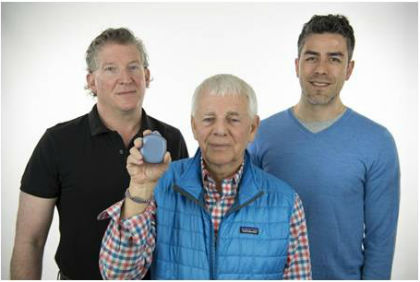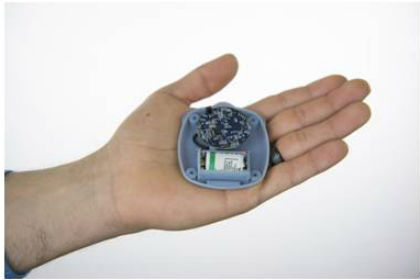|
NOVIDADES
But there is one possible option for reducing school shooting fatalities that won’t require waiting on compromises between parties or changes to public policy—active-shooter detection systems, said James Skorpik, of Pacific Northwest National Laboratory (PNNL). “Unlike arguments about gun control and the second amendment, there is no controversy against this,” said Skorpik, in an interview with R&D Magazine.“There is no downside.” While active-shooter detection systems do currently exist, most are generally designed for outdoor, urban environments. Skorpik, along with Michael Hughes and Eric Gonzalez at PNNL, have used their joint expertise in acoustical sensing, signal processing and embedded systems engineering to develop an inexpensive gunshot detector designed specifically for indoor detection. The innovation - known as Acoustic Gunshot Detection Technology - was a 2017 R&D 100 Award winner. It is about this size of a golf ball, battery powered and inexpensive to create, and can identify the shooter’s weapon type and caliber within seconds of firing. In most cases, one sensor can monitor an entire classroom, hallway or cafeteria. The motivation to create this technology came from the team’s personal experiences. “I’m a grandpa, I’ve got four grandkids in elementary school and Mike and Eric both have daughters in elementary school and in college so we’ve had a vested interest in providing some technology that helps these school administrators respond to a situation,” said Skorpik. Data derived from active shooter incidents show that one person dies for every 15 seconds a shooter is active and it takes two minutes on average for someone to call 911 and report a shooting. So advanced warning—even just a few minutes— about the presence of an active shooter to law enforcement can make all the difference, said Skorpik. “Part of the driving force was the Sandy Hook Elementary School shootings (Dec. 2012) where all of those little kids were killed, and by the time the first responders got there it was too late. And again, with the Parkland shooting there was seven minutes after the last shot went off before triage could come in and administer first aid and that is pretty much the period in which those 17 kids died,” he said.  James Skorpik, Michael Hughes and Eric Gonzalez, the creators of Acoustic Gunshot Detection Technology. Credit: PNNL
SecurityUSA Services, based in Albuquerque, New Mexico, has license PNNL’s Acoustic Gunshot Detection Technology for integration into their EAGL lockdown and reporting system. Two other groups are currently evaluating the technology for licensing as well. Using this technology, licensees have a variety of options in creating a system that improves school safety during a shooting incident. The sensor could be integrated with a program that immediately activates the school’s security system, turning on cameras, locking doors and implementing other lockdown measures. If a sensor is installed in each room, the technology could identify the location of the shooter and then, if paired with a reporting system, provide information regarding that location through text notifications to students, staff and law enforcement. This information would help staff and students evade the shooter and could quickly direct law enforcement to the threat. “Most systems that are out there work by detecting the passage of a shockwave and using that to infer where the shot originated, where it was fired from,” said Hughes, in an interview with R&D Magazine. “Those don’t work inside at all because there are too many obstacles that scatter the shockwaves so you can’t back out where the shot came from. In addition, inside the sound is strongly attenuated, it dies out too quickly to back out where the shockwave is coming from. Those systems were designed to be used outside, and they don’t translate to inside applications very well.” Acoustic Gunshot Detection Technology processes acoustic events in two steps. First, it assesses whether a sound is a gunshot. It does this by utilizing an algorithm that analyzes acoustic events to determine if those events have enough energy to be a gunshot. Firearm discharges generate relatively long acoustic signatures and in confined spaces like a classroom, echoes from a gunshot reverberate from the walls, ceiling and floor, completely filling the room. So the relative position and orientation of the firearm and Acoustic Gunshot Detection Technology does not matter. If a gunshot is detected, the second step is to classify the weapon type. For weapon-type classification, the initial shape of the acoustic signature is analyzed using entropy. The information contained in this part of the acoustic signature is analyzed in time-domain showing much greater sensitivity and specificity than frequency-domain analysis. Knowing what weapons they are dealing with during an active shooting can be extremely beneficial to law enforcement, said Hughes. “The police told us that they want to know if it is a long barrel weapon versus a short barrel because that effects the lethality of the shooter and also the threat they pose not only to civilians, but to law enforcement personal when they arrive,” he said. “We worked with three local law enforcements to get data and also Federal Law Enforcement Training Centers provided a lot of feedback.” The technology can distinguish between gunshots and other sounds, such as a slammed locker, popping balloon, or other noises that can be mistakenly identified as a gunshot by a human ear. Even in the presence of noise, such as a fire alarm, Acoustic Gunshot Detection Technology can detect a gunshot with high statistical certainty, which has been verified in live-fire experiments comprised of hundreds of live ammunition discharges using over a dozen different weapons. These included a local law enforcement training facility, a public office complex, and a two-story middle school. They published their findings in The Journal of the Acoustical Society of America. Rigorous testing was key to creating this technology, said Hughes. He drew on his background in pediatric oncology research, where he used his acoustic expertise to analyze ultrasound data to detect tumors. “Developing this technology was a lot like developing a drug and that is the experience I am used to from my medical research,” he said. “We needed lots and lots of trials, lots and lots of data because there is a lot variability out in the world and you don’t know if you captured it all unless you’ve done a lot of experiments.”  Acoustic Gunshot Detection Technology. Credit: PNNL
“We want something really small that could be easily installed,” said Skorpik. “We made it small portable, and easy enough that a school administrator or a janitor could install it. It is also inconspicuous—if it can blend into the environment it won’t be defeated as easily.” The device is battery powered and connects to other devices wirelessly. An individual sensor’s health is simply verified by “heartbeat” messages sent periodically to the security system. It is also relatively inexpensive, which is important for schools that are on limited budgets. The estimated cost for an Acoustic Gunshot Detection Technology sensor is less than $100, according to the research team. They are optimistic that costs will stay low once it is developed by commercial partners. “Technology continues to improve and once these licensees start buying or manufacturing these detectors in the hundreds of thousands, the price will actually keep on going down,” said Gonzalez, in an interview with R&D Magazine. “But as a starting point our cost is already fairly low.” The team was able to keep the costs down by keeping their design at the “bare minimum” and utilizing parts from other industries, explained Gonzalez. “A lot of the parts we are using are parts that the cell phone industry is using,” he said. “With how huge the cell phone industry has become, a lot of these parts are just being made in mass quantities and it is making all of the prices for these parts very low. It was easy for to use those same parts that don’t have a high price point and just incorporate them into our design.” “We’d like to go to malls, office buildings, musical events, stadiums, concert halls,” said Hughes. “We are hoping that one of the licenses is going to partner with us to gather the data on those environments.” After the Parkland, FL shooting where the fire alarm went off during the crisis, the team tested their technology while a fire alarm was going off, and determined it could still detect and identify gunshots over the noise and it was not triggered by the fire alarm itself. They would now like test their technology in other loud and unusual environments where background could give a false positive or obscure a true positive. “We’d like to find a government agency which would allow us to do some more studies to advance the algorithms and be more confident in every situation possible, “said Skorpik. “It would be good to get more data for scenarios that we haven’t tested yet as well. “ They also hope to continue to expand their commercial partnerships, while still maintaining the affordability of the technology. “The cost is one of the issues for the school systems, so our hope is that the licensees can maintain the low cost so that schools can get grants and as many schools as possible can get these installed,” said Skorpik. By Laura Panjwani. R&D. Posted: May 30, 2018. |
|||||||||||||||||||||||||